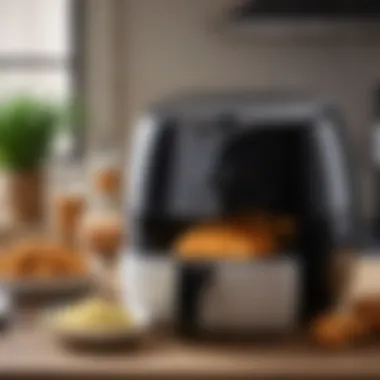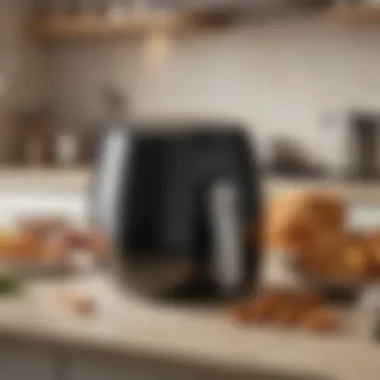Expert Tips for Cleaning Your Philips Air Fryer


Intro
Cleaning a kitchen appliance like the Philips Air Fryer requires a bit of know-how and attention to detail. Many food lovers embrace the convenience that air fryers bring, whipping up delightful dishes with minimal oil. However, neglecting to clean these machines can lead to built-up residue, unpleasant odors, and even potential health risks. This guide aims to demystify the cleaning process, providing you with clear steps and useful tips to keep your Philips Air Fryer in top shape.
Being a relatively new player in the kitchen appliance world, air fryers have quickly made their mark, transforming the way we cook. Philips, one of the pioneers in this space, has created a product that not only cooks meals efficiently but does so while retaining flavors and nutrients. But to enjoy these benefits fully, regular maintenance is key. Proper cleaning ensures that your meals taste their best and that your appliance lasts for years to come.
In the following sections, we will explore the essential techniques, recommended cleaning materials, and best practices tailored specifically for your Philips Air Fryer. Whether you're a seasoned chef or just starting out, this guide will equip you with the knowledge to tackle cleaning like a pro.
Foreword to the Philips Air Fryer
The Philips Air Fryer has become a staple in many kitchens, transforming the way we think about cooking. Known for its innovative approach to frying, broiling, and roasting, this appliance offers a healthier alternative to traditional frying methods. When discussing air frying, it’s essential to appreciate both the technology behind it and the various benefits it provides to home cooks.
Overview of Air Frying Technology
Air frying relies on rapid air circulation to cook food, similar to convection ovens but more efficient. The technology often includes a powerful heating element along with a fan that circulates hot air around the food. This achieves a crispy exterior while locking in moisture, giving that satisfying crunch reminiscent of deep frying, but with a fraction of the oil.
In this method, oil usage is significantly reduced—sometimes even eliminated—allowing for a myriad of dishes that can be prepped and cooked with ease. The Philips Air Fryer represents a convergence of convenience, taste, and health, enabling people to indulge without the guilt associated with excess fat and calories.
Benefits of Using a Philips Air Fryer
Owning a Philips Air Fryer can revolutionize your cooking experience for several compelling reasons:
- Healthier Cooking: As previously mentioned, air frying uses considerably less oil than traditional frying methods. This means lower calorie counts in your favorite fried foods, facilitating a healthier lifestyle without sacrificing taste.
- Versatility: This appliance isn’t just for frying; it functions as a grill, oven, and even a dehydrator. You can create everything from chewy cookies to succulent roasted veggies—all in one space-saving device.
- Easy Cleanup: Cleaning up after cooking can be a daunting task. The Philips Air Fryer's removable parts are often dishwasher safe, making clean-up less of a chore and more of a breeze. Plus, with no excessive oil splattering everywhere, your kitchen remains tidy.
- Time Efficiency: The rapid cooking times associated with air frying mean you can get meals on the table quicker. The technology reduces cook times when compared to conventional ovens.
- Consistent Results: This air fryer distributes heat evenly, resulting in perfectly cooked food every time. You can say goodbye to undercooked centers or overdone edges that sometimes plague traditional frying.
In summary, understanding the Philips Air Fryer is crucial for both current owners and potential buyers. By grasping the unique technology and the healthy cooking benefits, users are better equipped to leverage this kitchen marvel fully. With that, we can transition to exploring the importance of cleaning this appliance!
Understanding the Importance of Cleaning
Cleaning your Philips Air Fryer is more than just a chore; it’s a critical component of cooking delicious meals in a safe environment. When one considers the frequency with which these appliances are used - be it for crispy fries or golden chicken wings - the buildup of grease and food residue can become an issue. Not only does a lack of cleanliness affect the taste of your food, but it can also compromise your health.
Health and Hygiene Considerations
Keeping a clean air fryer is essential for health. Leftover food particles can harbor bacteria, potentially leading to foodborne illnesses. When the appliance does not get cleaned regularly, these residues can not only spoil the flavor of the current meal but also present a risk of contamination. It’s important to think of your fryer as a vital tool in your kitchen and treat it accordingly. Since air fryers operate at high temperatures, many might assume that they sanitize themselves, but that’s a misconception.
"A clean air fryer is a happy air fryer, ensuring your meals taste as good as they can."
Impact on Food Flavor and Quality
If you want your dishes to taste their best, cleaning your air fryer is non-negotiable. Oil and grime from previous cooking sessions can transfer unwanted flavors to your new dishes. Imagine biting into a beautifully cooked fish, only to detect the rancid taste of last week’s fries. Using a dirty appliance makes sense about as much as wearing socks with sandals—it just doesn’t! Clean surfaces help to maintain the original flavors of your food, allowing for a pure cooking experience. Plus, without the burnt bits and grime, you enhance the overall quality of each meal.
Extending the Lifespan of Your Appliance
Don’t overlook how cleaning can influence the longevity of your Philips Air Fryer. Regular maintenance not only boosts performance but can also prevent damage and wear over time. With consistent care, you’re likely to avoid costly repairs or replacements. Think of it like an investment: the more you take care of it, the more you get in return. A clean appliance runs efficiently, which, in the long run, saves energy and reduces wear on components. Neglect can lead to clammy circumstances like clogged vents or even electrical issues, so don’t let mess build up.
What You'll Need for Cleaning
Cleaning your Philips Air Fryer properly requires a few essential tools and materials that facilitate an effective scrubbing process. Using the right items not only ensures that your appliance remains in top-notch condition but also enhances safety while preparing your favorite dishes. Without the appropriate gear, you might end up causing more harm than good to the device. So, gather the right tools to make your cleaning endeavor smoother.
Essential Cleaning Tools and Materials
When embarking on the cleaning journey, consider having the following items on hand:


- Non-abrasive sponge: A soft sponge is key for gently scrubbing surfaces without scratching them. Avoid anything harsh; you don't want to mess up that non-stick coating.
- Microfiber cloth: This cloth is great for wiping down the outer body of the fryer. It leaves no lint behind, ensuring a clean finish.
- Brush: A small brush can be handy for getting into crevices that a sponge simply can’t reach. Think about using a soft-bristled brush to clear out food particles without causing damage.
- Bucket or basin: This is for rinsing off any removeable parts. Make sure it's big enough so nothing gets stuck or hard to move around.
- Squeegee or spatula: A plastic one will help to scrape off extra residue without scratching surfaces.
These tools collectively make the job easier and help maintain not just cleanliness, but also the overall integrity of your Philips Air Fryer. It's like having a toolbox for your air-frying adventures!
Safe Cleaning Solutions
Finding the right cleaning solutions is just as crucial as having the right tools. Here’s what to look for when selecting your cleaning aids:
- Dish soap: A simple dish soap mixed with warm water works wonders. It’s gentle on the appliance and tough on grime, just what you need for regular maintenance.
- Vinegar: It’s a natural deodorizer and works wonders for tough odors. Mix a bit with water to create a solution perfect for wiping down surfaces.
- Baking soda: Known for its magical cleaning properties, baking soda can tackle tough stains. A paste of baking soda and water can be a game-changer for troubleshooting stubborn marks.
- Food-safe cleaning sprays: If you prefer store-bought options, look for sprays specifically formulated for kitchen appliances. Make certain they are food-safe to prevent any unwanted flavors in your cooking.
Using appropriate cleaning solutions reduces health risks and keeps your air fryer in good shape. Keep in mind, you don’t want to resort to harsh chemicals—your Philips Air Fryer deserves better.
A clean appliance not only operates more efficiently but also helps to deliver food that truly satisfies.
So, as you prepare to tackle the cleaning of your Philips Air Fryer, arm yourself with these essential tools and solutions, and you’ll be well on your way to maintaining this culinary gem! Always remember, a little effort goes a long way in preserving your kitchen device.
Step-by-Step Cleaning Process
Cleaning your Philips Air Fryer might seem like a tedious task, but a systematic approach can make it as smooth as butter. By following a step-by-step process, you can ensure that not only is your appliance clean, but it also functions at its best, keeping your food delicious and safe. Cleaning effectively not only prevents unpleasant odors but also helps to uphold the quality of the food you prepare in the future. Let's dive into the nitty-gritty of cleaning your air fryer.
Preparing Your Air Fryer for Cleaning
Before you jump into scrubbing, it's essential to prepare your air fryer. First things first, make sure the appliance is turned off and completely cool. Trying to clean it while it’s hot is a recipe for disaster. Unplugging the device is a good practice to avoid any accidental activation. After that, gather all necessary tools and cleaning solutions. Having everything within reach ensures you won’t forget a step.
Ensure that you have:
- Soft sponges or cloths
- Mild detergent
- A soft brush or toothbrush for tight spots
- Water for rinsing
Taking these steps beforehand will help you tackle each component effectively.
Cleaning the Removable Parts
Cleaning the Basket
Let’s address the basket first. It’s the heart of your air fryer and often the most soiled part. Over time, grease and food particles can build up, which creates an unappealing layer. To clean it, soak it in warm, soapy water for about 15 minutes, allowing food residue to loosen up easily.
The material of the basket is typically non-stick, so using a non-abrasive sponge is a smart choice. Scrubbing gently ensures you don’t damage the coating. Regularly cleaning this part not only improves the taste of the food but also ensures that no leftover oils affect the texture of your next dish.
"Keeping your basket clean is akin to keeping your favorite pan well-seasoned. You’ll thank yourself later when every meal turns out just right!"
Cleaning the Tray
Next, let’s move on to the tray. The tray catches excess oils and crumbs, and like the basket, it also deserves some attention. After soaking it in warm soapy water, use a soft cloth to wipe it down.
Cleaning the tray is vital as it helps prevent any smoke issues when cooking, which can ruin your culinary adventures. Much like the basket, this part is generally designed with ease of cleaning in mind, often having a non-stick surface that helps with maintaining hygiene.


One thing to be mindful of is not to use harsh chemicals that might linger even after rinsing. Keeping the tray clean is key in extending its lifespan and ensuring each meal is to die for.
Cleaning the Outer Body
Once the removable parts are spotless, it's time to freshen up the outer body of the air fryer. Use a damp cloth with a drop of mild detergent to wipe down the outer surfaces. Avoid submerging any part of the air fryer in water. A clean outer body not only looks great but also ensures that dust and grime don’t hitch a ride into your cooking.
Remember, the air fryer’s outer shell can heat up during cooking, so allow it to cool down before cleaning. Taking this simple step can protect your appliance and your hands.
Dealing with Stubborn Stains
Every now and then, tough stains can be a headache. If you encounter residue that water and soap can’t touch, try a paste made from baking soda and water. Apply it to the stained areas, leave it for a few minutes, and then scrub gently. This method works wonders for almost any greasy disaster.
Patience is key here. The baking soda acts as a mild abrasive, breaking down those pesky spots without damaging the surface. Just remember, don’t apply too much pressure – that can lead to scratching.
Common Mistakes to Avoid
When it comes to cleaning your Philips Air Fryer, avoiding certain pitfalls can make all the difference. Making these common mistakes can lead to damaged components, compromised food quality, and in the long run, it could even shorten the lifespan of your machine. Let’s explore specific errors that folks often make and how steering clear of them can enhance your cooking experience.
Using Abrasive Materials
One of the blunders that many air fryer owners fall into is reaching for abrasive cleaners or scrubbers. This mistake stems from the belief that tougher grime requires tougher tools. In reality, using materials like steel wool or harsh sponges can scratch the non-stick surfaces, resulting in flaking over time. Scratches not only affect the appliance’s performance but can also lead to food sticking and cooking unevenly.
Instead, opt for soft sponges and gentle dish soap. Protecting that non-stick coating means meals will turn out just as you’d planned—crispy on the outside and tender on the inside without the nuisance of food residue.
Ignoring the Heat Element
The heat element may seem a secondary concern while cleaning, but neglecting it can lead to unappetizing surprises the next time you cook. When you fry up those delicious sweet potato fries, if the heating element is coated with grease or food particles, it can smoke or even emit odd odors. This could change the flavor of your food and ruin your dish entirely. Be diligent and periodically check the heat element, making sure to clean it carefully without damaging its surface. Just a damp cloth or sponge should do the trick, along with a little gentle detergent if necessary. Even if it’s out of sight, it should never be out of mind—your palate will thank you for it!
Overuse of Cleaning Solutions
While it seems logical to think more cleaning solution equals a cleaner appliance, this can actually backfire. Many cleaning agents contain chemicals that can linger and affect the flavors of your food. Excessive use can also lead to buildup within the air fryer's components, which can harm the internal parts over time. Focus on a balanced approach. A few drops of dish soap mixed with warm water can be more than enough for a thorough clean. You'd want to rinse the parts properly, making sure no cleaner remains when you reassemble and use your air fryer. Your meals deserve purity in taste, right from the first bite to the last.
"An ounce of prevention is worth a pound of cure."
Recognizing and avoiding these common mistakes sets the stage for a well-maintained appliance, enhancing not only its performance but your culinary results as well.
Regular Maintenance Tips
Maintaining your Philips Air Fryer goes beyond the occasional wash and scrub. Regular maintenance is essential for prolonging its life, ensuring optimal performance, and keeping your meals safe and delicious. Think of it as giving your favorite kitchen gadget a little TLC, because a well-maintained air fryer will reward you with flavorful meals that rise above the rest.
Good care habits can make a massive difference in your cooking experience. Moreover, a clean air fryer means food tastes better, primarily because remnants from previous meals no longer linger. Regular maintenance can even save you time by reducing the effort required for deep cleaning sessions after cook-a-thons.
Establishing a Cleaning Schedule
Establishing a cleaning schedule for your Philips Air Fryer is akin to having a reliable GPS for your cooking journey. It sets a path forward, ensuring that your appliance stays in tip-top shape. Ideally, troubleshooting how often you use your air fryer will help in planning a suitable cleaning routine.
- Daily Wipe Down
After every use, a quick wipe of the basket and tray keeps stubborn residues at bay. All it takes is a damp cloth or sponge with warm soapy water. This little routine can prevent the build-up of grease and crumbs, enhancing your next cooking session. - Weekly Inspection
Take a moment weekly to inspect components, making sure they aren’t exhibiting any wear and tear. Check for hidden food particles, especially around the heating element, and cleanse effectively. - Monthly Deep Clean
Set aside a day each month for a deep clean. This involves soaking removable parts in warm water, scrubbing away at those hard-to-reach spots, and thoroughly cleaning the heating element. Don’t forget to pay attention to the air inlet and outlet, as those can gather dust and grime.
By adhering to a structured cleaning plan, you won’t just rely on good luck for a clean air fryer; rather, you’ll build culinary success brick by brick, creating a lasting impact on food quality.


Prevention of Food Residue Build-Up
Preventing food residue build-up is something of a delicate dance. Once food begins to cling, cleaning becomes a daunting task, escalating into a full-blown battle. However, with some savvy moves and practices, you can keep your air fryer in pristine shape.
- Utilize Parchment Paper
Consider lining the basket with parchment paper. This simple trick can act as a protective barrier, minimizing residue attachment and making clean-up a breeze. Just be cautious with airflow; ensure the paper doesn’t block vents. - Avoid Overcrowding
When preparing your favorite recipes, resist the urge to cram the basket full. Overcrowding can lead to uneven cooking, resulting in unappetizing remnants. Cooking in batches allows each piece to crisp up beautifully, making for a tastier experience. - Use A Coating Wisely
Watch how much oil you use. A light misting is your friend, while excessive oil leads to further residue. Stick to recommended amounts for extended smooth operation and easy clean-up. - Immediate Cleaning After Use
Don’t let the remnants harden or stick stubbornly in the basket. Cleaning right after use not only avoids future hassle but also keeps the components fresher.
By implementing strategies that proactively hinder residue build-up, you ensure that your Philips Air Fryer remains a reliable ally in the kitchen, effortlessly cooking up delights without hostility from stubborn remnants.
Commonly Asked Questionss About Philips Air Fryer Cleaning
Cleaning an appliance like the Philips Air Fryer isn’t just about keeping it shiny and new; it’s also a matter of performance and safety. In this section, we’ll address some frequently asked questions, shedding light on both the practical aspects of maintenance and those little nuisances that might spark your curiosity. By understanding how to care for your air fryer properly, you can ensure that it functions at an optimal level, delivering delicious meals while avoiding any mishaps or health risks.
Can Put Parts in the Dishwasher?
This question often comes up, especially for those who appreciate the convenience of a dishwasher. Generally, many of the removable components of the Philips Air Fryer, such as the basket and tray, are designed to be dishwasher safe. However, it's crucial to consult the manual that came with your appliance to confirm. Some users have found that while certain parts handle the dishwasher just fine, others may suffer wear or fading due to high heat or aggressive detergents. If you're going the dishwasher route, it’s best to place them on the top rack to minimize exposure to excess heat.
- Pro Tip: Always allow your air fryer parts to cool down before placing them in the dishwasher. This simple step helps prevent warping.
How Often Should Clean My Air Fryer?
Ah, the million-dollar question! Ideally, you should clean your Philips Air Fryer after each use. This may sound like a chore, but it isn’t as daunting as it seems. A quick wipe of the basket and tray, along with a rinse, takes just a few minutes. For a deeper clean, aim for one to two times a month.
- Key Reasons for Regular Cleaning:
- Maintains food quality: Old residues can alter the taste of fresh meals.
- Prevents health risks: Keeping things sanitized is a must for any kitchen tool.
- Prolongs the appliance's lifespan: Regular care means fewer repairs.
What If Accidentally Use Metal Utensils?
Oops! It happens. Using metal utensils in your air fryer can potentially scratch the non-stick coating, leading to peeling over time. If you’ve found yourself in this predicament, don’t panic. Inspect the surfaces for scratches or damage. If you notice minor scratches but nothing that looks alarming, just avoid using metal in the future and switch to wooden or silicone tools instead.
Remember that preventing damage is much easier than dealing with it later on!
To summarize, having a Philips Air Fryer is a joy, but maintaining it is key to enjoying all it has to offer. So keep these FAQs in mind, and your air fryer will serve you delicious meals for years to come.
Epilogue
Cleaning your Philips Air Fryer is not just a chore; it plays a pivotal role in ensuring your kitchen appliance continues to deliver splendid results. Regular cleaning protects your investment, enhances flavor quality, and safeguards your health. Essentially, the cleanliness of your air fryer directly impacts the food you prepare and the overall experience of cooking with it.
Summarizing Best Practices
To maintain your Philips Air Fryer in tip-top shape, adhering to best practices is crucial. Here are the key takeaways to keep in mind:
- Routine Cleaning: Don’t wait for the appliance to show signs of grime. Make it a habit to clean the fryer after every few uses.
- Gentle Approach: Use soft cloths and non-abrasive sponges to avoid scratching surfaces. Avoid steel wool or harsh chemicals; they can damage the non-stick coating.
- Deep Cleaning Periodically: Schedule a deeper clean at least once a month. This is when you focus on difficult areas like the heating element and tight spaces.
By incorporating these best practices into your routine, you normalize the cleaning process, making it feel less daunting.
Encouraging Consistent Maintenance
Consistency is the cornerstone of care for your air fryer. Establishing a cleaning routine promotes longevity and efficiency in an appliance that sees regular action. Here’s how you can make maintenance second nature:
- Create a Schedule: You might consider marking a calendar for cleaning days or setting reminders on your phone. This helps in building a habit towards maintenance.
- Keep Supplies Handy: Place your cleaning supplies close to where you store the device. Having everything you need within arm’s reach makes it easier to follow through after cooking.
- Educate Yourself: Sometimes, a little knowledge goes a long way. Familiarize yourself with your specific model and its features; this way, you’ll understand what’s safe to use for cleaning.
With consistent effort, cleaning the air fryer can transform from a necessary task into a quick, easy action that you hardly think twice about. High-performing kitchens demand high standards of cleanliness, and your Philips Air Fryer deserves nothing less.







